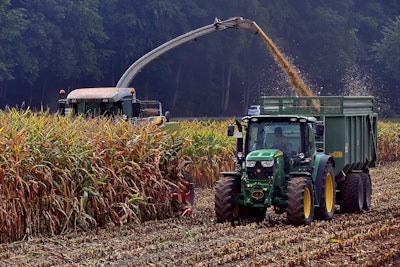
The USDA released its November World Agricultural Supply and Demand Estimates (WASDE) report on Wednesday.
The USDA noted there were record high corn yields in several states this harvest season including California, Illinois, Virginia, Washington and Wisconsin, with central Illinois being highlighted as a 'bright spot.'
Also noted were declines in corn yields in several Western states impacted by drought.
Earlier in the week, USDA released its unofficial annual ‘baseline’ forecasts projecting that U.S. farmers are likely to expand plantings of corn and wheat for the upcoming 2023/24 marketing year, while reducing soybeans.
According to reports, this Baseline Projections report may give grain traders the sense that U.S. crop sizes may bounce back next year, with USDA showing 2023 corn acreage at 92 million acres with a yield of 181.5 bushels/acre and soybean acreage at 87 million acres at 52 bushels /acre.
November WASDE
WHEAT
The outlook for 2022/23 U.S. wheat this month is for stable supplies, increased domestic use, unchanged exports, and slightly lower ending stocks.
Total domestic use is projected 5 million bushels higher at 1,093 million as an increase in food use more than offsets a decrease in seed use.
Food use is raised 7 million bushels to a record 977 million on strong calendar year third quarter wheat ground for flour reported in the latest NASS Flour Milling Products.
All wheat exports are unchanged at 775 million bushels, with offsetting changes for White wheat and Durum. Projected 2022/23 ending stocks are lowered 5 million bushels to 571 million, the lowest level since 2007/08.
- Projected 2022/23 season average farm price for wheat is unchanged at $9.20/bushel
The global wheat outlook for 2022/23 is for increased supplies, consumption, trade, and ending stocks.
Supplies are projected up 1.3 million tons to 1,059.0 million based on increases in beginning stocks and production.
World production is raised 1.0 million tons to 782.7 million as larger production in Australia, Kazakhstan, and the UK more than offsets declines in Argentina and the EU.
Production in Australia is raised 1.5 million tons to 34.5 million as above average rain over the past month supported crop development and boosted yields, following widespread favorable conditions earlier in the growing season.
Argentina production is lowered as continued widespread dry conditions through most of October further eroded yield potential, especially in northern areas.
Feed and residual use is raised 0.9 million tons as increases in the EU, South Korea, the Philippines, and Vietnam more than offset a decline in India. FSI consumption, however, is lowered 1.5 million tons primarily on decreases for Bangladesh and Indonesia.
The global forecast for trade is increased 0.3 million tons to a record 208.7 million, primarily on higher exports from Australia, Kazakhstan, and the UK that more than offset a reduction in exports by Argentina.
Projected global ending stocks are increased 0.3 million tons to 267.8 million, with increases for Australia and India and a decrease for the EU accounting for most of the change
COARSE GRAINS
This month’s 2022/23 U.S. corn outlook is for higher production, larger feed and residual use and greater ending stocks.
Corn production is forecast at 13.930 billion bushels, up 35 million from last month on a 0.4-bushel increase in yield to 172.3 bushels/acre.
Feed and residual use is higher based on a larger crop. With supply rising more than use, corn ending stocks are raised 10 million bushels.
- Season-average corn price received by producers is unchanged at $6.80/bushel
Global coarse grain production for 2022/23 is forecast fractionally lower at 1,459.5 million tons.
This month’s 2022/23 foreign coarse grain outlook is for reduced production, lower trade, and smaller stocks relative to last month.
Foreign corn production is forecast lower as declines for the EU, South Africa, Philippines, and Nigeria are partly offset by increases for Angola, Mali, Pakistan, Turkey and Senegal.
Corn production in the EU is down based on decline for Hungary. South Africa is reduced based on lower expected area.
Barley production is lowered for Argentina but raised for Australia and the EU. Major global trade changes include lower corn exports for South Africa.
Corn imports are reduced for Vietnam, Algeria, and Turkey. For 2021/22, corn exports for Argentina are cut for the local marketing year beginning March 2022, based on shipments observed through October.
For 2022/23, barley exports are raised for Australia but lowered for Argentina and Russia. Barley imports are reduced for China.
Foreign corn ending stocks are down, mostly reflecting declines for Nigeria and South Africa that are partly offset by an increase for Vietnam.
Global corn ending stocks, at 300.8 million tons, are down 0.4 million.
OILSEEDS
The U.S. soybean outlook for 2022/23 is for increased production, crush and ending stocks.
Soybean production is forecast at 4.35 billion bushels, up 33 million on higher yields. Higher yields in Iowa and Missouri account for most of the change in production.
Soybean crush is raised 10 million bushels on an increased domestic soybean meal disappearance forecast. With exports unchanged, soybean ending stocks are raised 20 million bushels to 220 million.
- U.S. season-average soybean price for 2022/23 is forecast at $14/bushel, unchanged from last month
- Soybean oil price is also unchanged at 69 cents/pound
- The soybean meal price is forecast at $400/short ton, up 10 dollars
Global oilseed production for 2022/23 is projected at 645.6 million tons, down 1.0 million from last month.
Lower soybean, sunflower seed and cottonseed production is partly offset by higher rapeseed.
Global soybean production is down 0.5 million tons to 390.5 million, mainly on lower production for Argentina.
Area harvested for Argentina is reduced reflecting incountry estimates.
Sunflower seed production is reduced for Ukraine on lower reported yields.
Global rapeseed production is raised 1.0 million tons to 84.8 million on higher yields for Australia and the EU.
Global oilseed ending stocks are projected at 121.9 million tons, up 1.4 million.
Soybean stocks account for most of the change with an increase to China’s stocks based on a revision to 2021/22 imports.
Another notable oilseed change includes lower palm oil production for Malaysia, which is reduced 1.0 million tons to 18.8 million. With reduced Malaysian palm oil supply and no change in exports, ending stocks are lower.
The World Agricultural Supply and Demand Estimates (WASDE) is prepared and released by the World Agricultural Outlook Board (WAOB). The report is released monthly, and provides annual forecasts for supply and use of U.S. and world wheat, rice, coarse grains, oilseeds, and cotton.
Read the full November 2022 USDA WASDE here.
















